As a caregiver, you are always looking for ways to improve the lives of those you care for. In this case, your four-legged friends. Have you ever wondered about using a clicker for training your dogs? If so, this guide is for you.
What is a Clicker?
A clicker is a small handheld device that produces a distinct, consistent sound. This sound is used as a cue to let dogs know when they have done something right. It’s a simple, yet effective, way to communicate with your dogs and guide their behavior.
- Consistency: The sound a clicker makes is always the same. This consistency helps dogs to understand and remember the behavior that is being reinforced.
- Speed: The clicker sound is immediate. It can mark the exact moment a desired behavior occurs, helping dogs to make the connection between their action and the reward.
The Science Behind Clicker Training
Clicker training is based on the psychological concept of operant conditioning. This is a learning process through which behavior is modified by rewards or punishments. In clicker training, the sound of the clicker is the positive reinforcement.
- The Click: This is the sound made by the clicker. It marks the moment that the dog performs the desired behavior.
- The Reward: This follows the click. It can be a treat, a toy, or anything that the dog enjoys.
The table below illustrates the sequence of events in clicker training:
| Step | Action |
|---|---|
| 1 | The Click |
| 2 | The Reward |
How to Use a Clicker for Training
Using a clicker for training involves a simple process that you can follow:
- Choose the Behavior: Decide on the specific behavior you want to train your dog to do.
- Mark the Behavior: As soon as your dog performs the desired behavior, click the clicker.
- Reward the Behavior: Immediately after clicking, give your dog a reward.
Remember, timing is crucial in clicker training. The click and the reward must follow the desired behavior closely for the dog to make the connection.
Why Use a Clicker?
There are several reasons why you might choose to use a clicker for training your dogs:
- It’s a clear and consistent signal.
- It can speed up the learning process.
- It’s a positive and non-threatening method.
- It can be used to train a wide range of behaviors.
Troubleshooting Common Problems
Like any training method, clicker training can have its challenges. You might find that your dog is scared of the clicker sound, or that they are not responding to the training. Don’t worry, these issues can be addressed with some patience and persistence.
FAQs
Q: Can I use a clicker for any breed of dog?
A: Yes, clicker training can be effective for all breeds of dogs.
Q: How long does it take to see results with clicker training?
A: It can vary depending on the dog and the specific behavior, but you may see results in as little as a few training sessions.
Q: Do I need to use treats with clicker training?
A: While treats can be a good motivator, they are not the only reward you can use. Praise, toys, or play can also work.
Q: Is it too late to start clicker training with an older dog?
A: No, dogs of any age can learn new behaviors with clicker training.
Q: Can I use the clicker to stop bad behaviors?
A: Clicker training is best used to reinforce positive behaviors, not to punish negative ones.
In conclusion, clicker training can be a powerful tool for training your dogs. It’s simple, positive, and effective. As a caregiver, using a clicker can help you foster a closer bond with your dogs and improve their behavior in a loving and supportive way.



